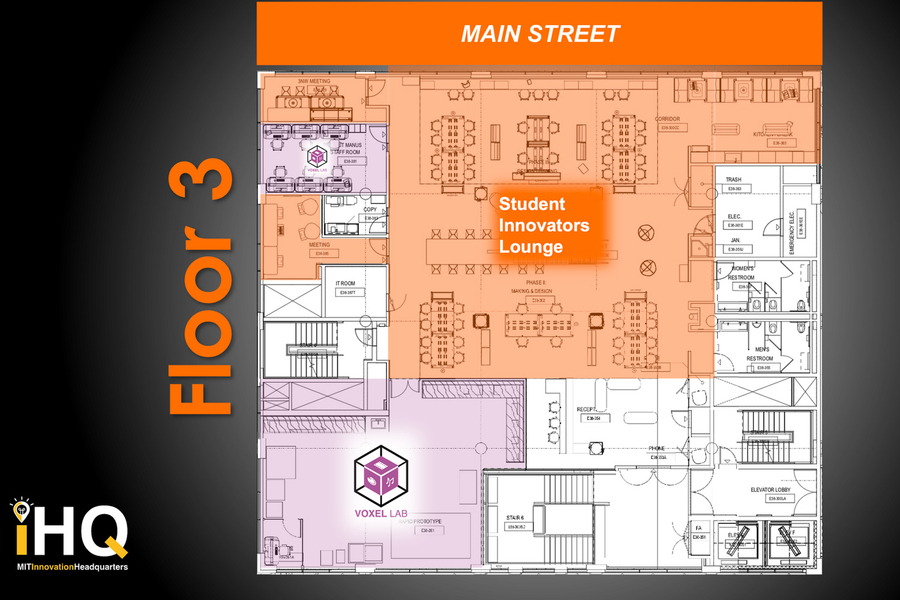MIT’s innovation and entrepreneurship community just got 50,000 square feet of new space to work with.
The Institute’s new InnovationHQ encompasses five floors in the recently renovated Suffolk Building, or E38, in the heart of Kendall Square. It serves as a hub for students at every stage of their entrepreneurial journeys, from undergraduates to PhDs, and includes space for alumni, faculty members, and staff.
“IHQ was designed to encourage those chance collisions which spark the innovation process amongst people and teams who may not otherwise meet,” says Fiona Murray, the associate dean for innovation and inclusion in MIT’s Sloan School of Management and the co-director of MIT Innovation Initiative (MITii), which designed the space with architects NADAAA and Perkins + Will.
Each floor features open, flexible layouts, and six departments, labs, and centers that formerly supported student entrepreneurship from different parts of campus now call it home. Conference rooms, meeting areas, and staff office space are also available.
What the space ultimately looks like on a day-to-day basis, though, will largely be decided by students.
“I anticipate it feeling warm and welcoming and creative and quirky — very student-driven,” says Lauren Tyger, a program manager with the MITii who heads student experience, including the new Student Venture Studio on the fourth floor.
Built with a purpose
The first thing students will notice about iHQ is what it sits on top of. The first two floors of E38 are home to the newly created MIT Welcome Center and MIT Admissions, sending a message to prospective students and visitors that innovation is encouraged at MIT.
“We’re trying to center innovation and entrepreneurship as a core experiential learning component, rather than just something you do on the side or something you do if you have the luxury of having extra time,” Tyger says. “This will help spark the understanding as a student that you’re empowered to innovate at MIT.”
Floors three through seven make up iHQ, with each level designed to enhance students’ ascent into entrepreneurship.





Most of the third floor is the new MIT Student Innovator Lounge — an open work area for community members to gather. It also includes a new makerspace for music and arts innovation called the Voxel Lab — a collaboration of MITii, the Arts at MIT, and MIT Music and Theater Arts. The fourth floor features the MIT Sandbox Innovation Fund Program as well as the new MIT Student Venture Studio, a space for student organizations interested in entrepreneurship to gather and host events and meetings.
“One of the obstacles the [Student Venture Studio] addresses is the challenge of collaboration and even awareness among student organizations of who’s doing what, who cares about what, who’s working on solving related problems,” Tyger says.
The fifth floor is the new home of the Legatum Center for Development and Entrepreneurship at MIT and houses the new MIT Alumni Venture Studio, which provides a space for MIT alumni, alumni founders, and MIT-connected ventures to engage with the many alumni innovation and entrepreneurship programs and opportunities offered on campus.
The sixth floor features longtime MIT entrepreneurial staples MIT Venture Mentoring Service and the MIT Deshpande Center for Technological Innovation. The floor also includes the New England I-Corps at MIT program and the MIT Innovation Initiative. All of those programs are topped by a large event space dubbed the Hacker Reactor on the seventh floor.
Tyger says consolidating a number of groups will do more than just save students trips across campus. “It will really help the offices themselves to collaborate more efficiently and effectively,” Tyger says. “Then from the student perspective, there may be less duplicative events and offerings. If we’re together more often, and talking, it will lead to more efficient, thoughtful, and robust offerings for students.”
No single building can house the entirety of innovation at MIT. So, other organizations like the Martin Trust Center for MIT Entrepreneurship, the PKG Center, MIT D-Lab and others, while not physically located in the building, are connected to the hub through MIT’s thriving I&E ecosystem.
Launching iHQ
MIT InnovationHQ is the culmination of a process that began back in 2013 when President L. Rafael Reif charged the MITii with creating “a chain of new and existing spaces that would, together, create an infinite innovation corridor to include a new innovation center.”
In the years since that charge, MITii has been working with students, faculty, alumni, and staff to learn more about what MIT’s innovation community needs and to build physical and data infrastructure to support those needs.
“Clearly there was a need for extremely flexible space,” Innovation Initiative Program Director Tim Miano says. “You need something akin to the Harry Potter Room of Requirement, or the Star Trek Holodeck, where spaces have the ability to accommodate as many people as possible and everything is rearrangeable to serve whatever activity is taking place. At the other end of the spectrum, there are very low-flex spaces that serve private activities.”
MITii is hosting a series of welcome events to introduce students to the new space, including First Year Exploration Day, a career exploration event, an I&E resource roundup open to all students, and more. But many of the experiences iHQ is built for will be less formal.
“We anticipate students having 24-hour access to the building, so some of the most interesting and exciting things may be happening at 2 o’clock in the morning amongst the students,” Miano says.
As the space starts being used more regularly, MITii will listen to the community and consider ways to adapt or improve its operations.
In that sense, the building is being run on the same principles as a startup, in which founders must keep their ear to the pavement to ensure they’re fulfilling customer needs.
“In a lot of ways, we’re all participating in the innovation process by continuing to talk to people, making the product stronger, and iterating on it from feedback,” Tyger says. “All that will really benefit the student experience.”









